Tarini Sethi, founder of The Irregulars Arts Festival, believes the role of an artist in society is to help transcend barriers like language.
I started curating shows five years ago from a personal need to showcase my work. I had begun to speak to many artists and realised that there was a desperate need for platforms in our country, besides traditional gallery spaces.
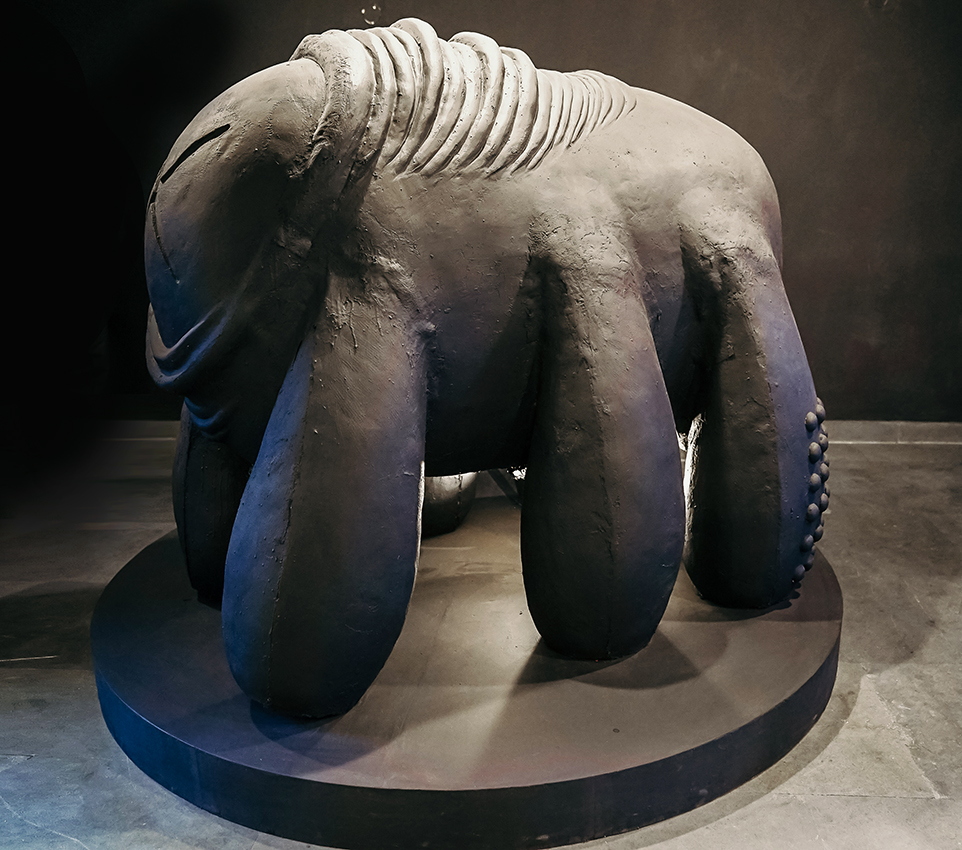
Anand Radhakrishnan
How did your journey in the art world begin? How do you describe yourself in the context of challenging people’s perspectives via your work?
My start to art came early. Like a lot of children I drew constantly and on every kind of surface. My parents being creative people themselves gently nudged me towards the art of making and using my hands, and sometimes my feet, as much as possible. My mother has always been interested in art, particularly folk art and craft. Our house, since I can remember, has always been covered from the floor to the ceiling with interesting and odd paintings as well as sculptures. Growing up around so much talent and story-telling made art an intrinsic part of me.
I studied art throughout school and also went for classes three times a week outside of school. This was great because we didn’t learn art in an academic way. We learnt about every kind of material possible and the different ways we could use it. We were encouraged to make three suns instead of one in a landscape and work with our mistakes. We were encouraged to keep sketchbooks and fill them up with notes to ourselves, sketches and finished drawings.
By the time I had finished my undergraduate degree in political science at LSR, where I barely ever studied, I was itching to make art in a more scholastic setting. I went on to major in drawing at the Pratt Institute in New York City, which were the most defining years of my artistic life. I was exposed to some really talented and interesting professors. They would take out the time to sit with you over a coffee for hours discussing art.
We would visit every gallery and exhibition – from the more established ones to lesser known underground events. I learned that the definition of art is not any one thing and, most importantly, the definition of an exhibition is not generic either.
I am constantly trying to improve, challenge, and question. I would always rather have my work bring out a negative reaction in a viewer than none at all. Art exists not just to soothe but to tell a story. I try my best to push the subject of my drawings and the intent of each character, so it constantly makes people think.
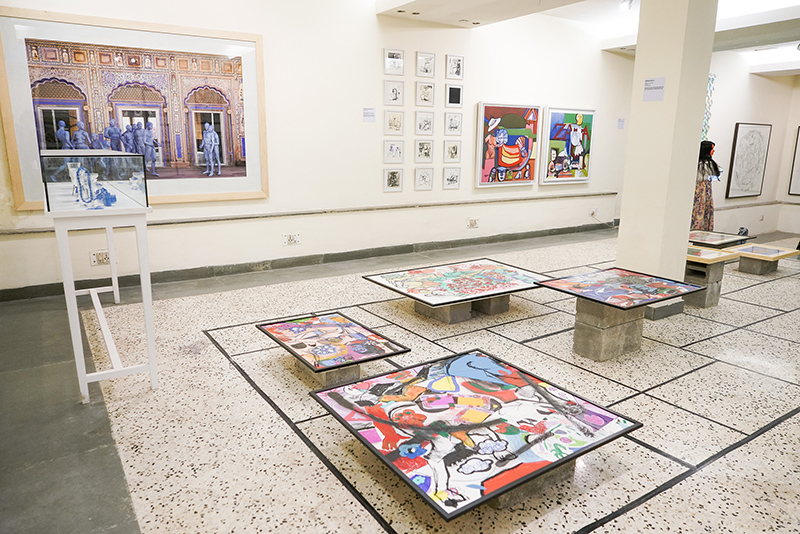
Raghav Bhall, Vikramaditya Sharma, Gyanendra pratap Singh
What inspires you?
I can get completely lost in Indian folk tales and mythologies. The story of gods and goddesses and how they came about or lost their powers, their destructive and intense love that could quickly turn to war. I also love Mughal miniature paintings of both “utopias” and “karnibharni”, which essentially means reap as you sow, which is a stark comparison between the extravagant lives of the rich and the punishments they meted out to each other.
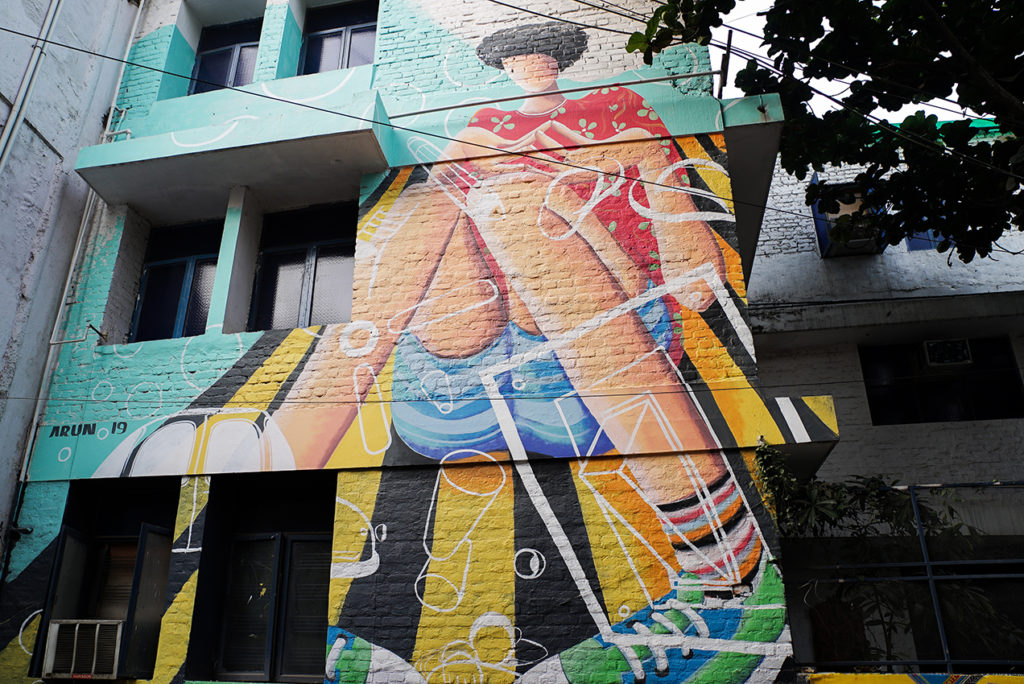
Arun Sharma
How did you deal with the conceptual difficulty and uncertainty of setting out to create something that no one else has aspired to?
My career really started after coming back from art school. Being in New York and seeing people with limited resources hustling, curating shows and moving all the time was an inspiration.
I came back to Delhi and was in a lull for a while because my work did not suit the market here. I was told by many people that they wouldn’t want to hang my work on their bedroom walls because it had too much nudity and absurdity, and that I should change my subject matter to please the Indian market. I took this criticism and decided to make my work even more absurd and with many more nudes. I also started curating my own events for artists who were facing similar issues and needed a platform to show their work.

Snakes And Ladders by Tarini Sethi
Take us through your process and the continuous frameworks of reference, which led to the birth of The Irregulars Art Fair (TIRAF). Feel free to mention other works.
I started curating shows five years ago from a personal need to showcase my work. I had begun to speak to many artists and realised that there was a desperate need for platforms in our country, besides traditional gallery spaces. The shows lasted a week and took over whatever space that was available. I started with the top floor of a design studio.
Since many talented artists started applying, which meant a lot of artworks, we chose to display everything in the Paris salon style wherein art is hung from the floor to the ceiling. During this time I also constantly read about curation, exhibition design, and the huge and extravagant alternative shows taking place in Europe and the United States. In particular, the SPRING/BREAK art show in New York, St+art in India, and Trimarchi in Argentina really spoke to me. They started small, were extremely DIY and maintained the idea that they were first and foremost for the artists, not gallerists and the collectors. Trimarchi and St+art also made the shows as accessible as possible to the public, so as to change the idea that art is for the elite. The TIRAF was set up with these values in mind.
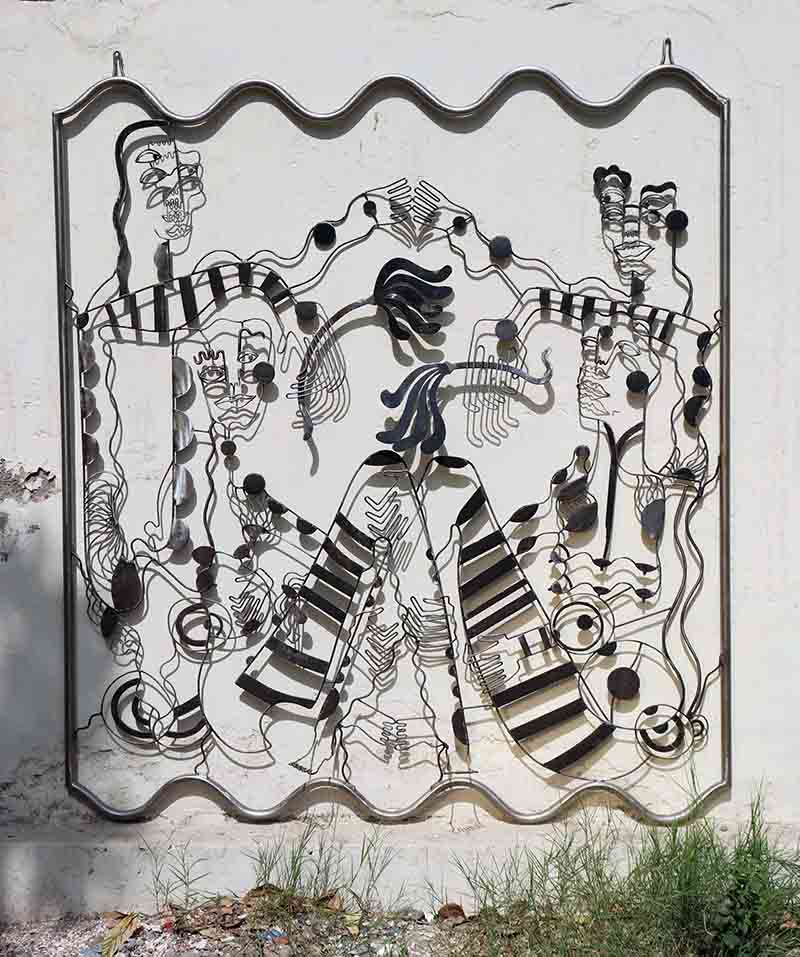
How did it all come together? What were the biggest challenges?
The first edition of TIRAF, a three-day event, came together on a whim, with a team of two. It was the most manic month of my life. We put together everything, including a website in a month and a half. We got access to a building which was in shambles at the time. The previous occupant had left behind 40 years worth of machinery, furniture and trash. I would go in every morning at 9 am and stay there till 7 pm for a month, cleaning the space.
We called a friend and got a basic website made. Then we started to tell people about it and asked them to tell their friends and so on. That’s how our publicity worked at the time, and still does in fact.
What I have learned through this process and my life, is that the most important things are learned on the job, not from books or lectures. One needs to be on the ground and making mistakes. This is exactly how the first edition went – we made many mistakes and had many successes.
There were artists from all walks of life, some of whom had been practicing for more than twenty years and TIRAF happened to be their first show, all because of a lack of resources and spaces in Delhi. They also got to meet other artists and buyers, and were actually able to display their work outside of social media. Our first edition saw many bumps. We were a tiny team trying to do something big, which meant everyone had to do everyone’s job. Our greatest success was that the artists were happy.
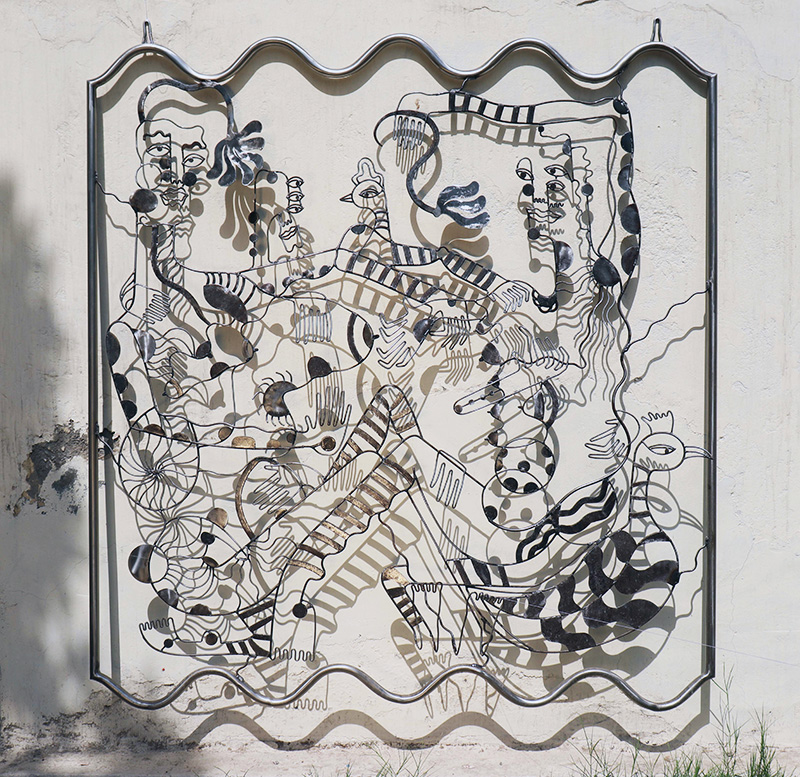
What do you look for in an artist’s work? Which shows, performances and experiences have shaped your creative process? Who are your maestros? Whose journey fascinates you?
We list down certain guidelines during the application process. The first thing we need an applicant to do is to answer every question we ask. A submission is not an easy process. We want the artist to sit down and think carefully before they answer the questions.
An important aspect of TIRAF is that we make sure the application process is egalitarian in nature. The show is open to everyone from every age group, race, gender and socio-economic background. We want to see that the artist is willing to push themselves, and that the work that they submit is the best they have. Undoubtedly, there are many younger artists who are not as well versed in the application world and don’t know how to edit their work, and in this, if we see something interesting we always have a telephonic conversation with them to see what else they can offer.

Migration
How do you balance art and life?
My art and my life are so intrinsically connected yet so far apart that there are times when there is no balance at all. One has to learn how to spend their days making art without forgetting themselves. I do get wrapped up in my work and forget the world around me, and vice versa. I tend to take weeks off art to live life. I try to carry a small sketchbook wherever I go so I’m always jotting down my thoughts or making quick drawing ideas when I can’t be at my desk and my art supplies.
How did the audience interact and react to the unexpected vis a vis your work?
That’s an interesting question, one that I try my best not to think about when I am creating because it often affects the kind of work I make and my process. It is for the most part appreciated, with humour and questions, which is all I could really ask for.
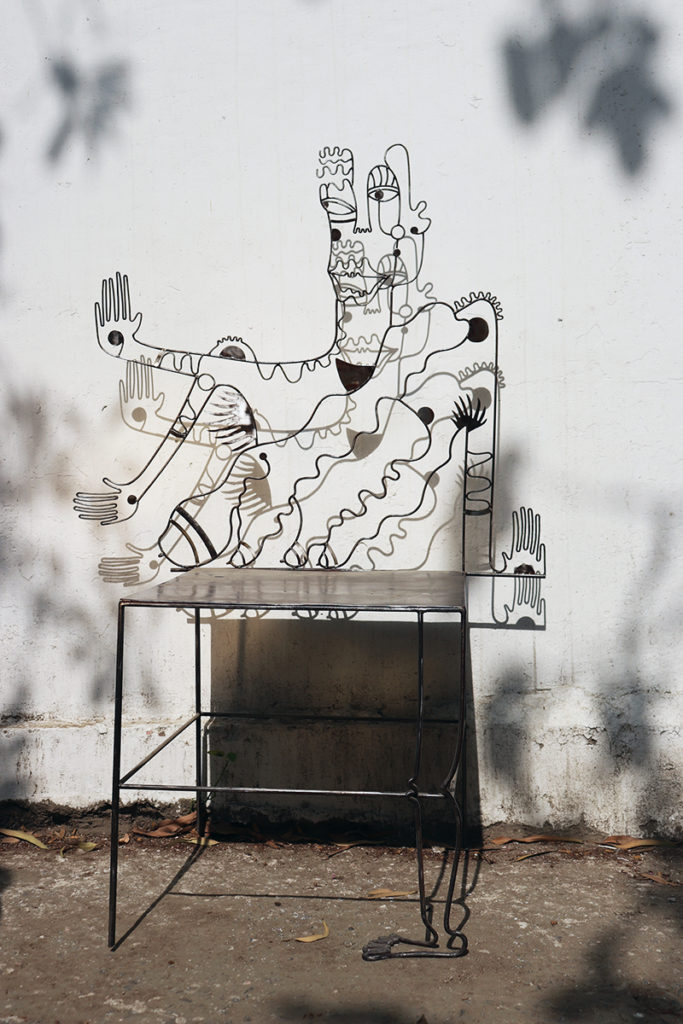
Chair 7
Are you collaborative by nature? What are the some of the formative collaborations you have been a part of?
Yes! Being an artist means there are times when you tend to isolate yourself from the world for days so you can create something genuine. Because of this I try my best to collaborate as much as I can with artists from different genres and spaces. This allows me to step out of that mindset and learn from others.
An interesting one from a few years ago was when I made the artworks for rickshaws in Varanasi in collaboration with Purpose Climate Lab and Taxi Fabric. Another great collaboration was with a fashion designer, ‘Mae.co’, who shows a lot of her clothes through videos. I made a stop motion animation over one of her videos.

Harmann Taneja and Santanu Hazarika
What according to you is the role of an artist in society?
To transcend language and other barriers.
Tell us about your own personal evolution in relation to the community.
Professionally, I have grown a lot when it comes to my art and the way I see myself in the Indian art market. I can now, after a long time, confidently call myself a fine artist and challenge people when they don’t understand the meaning of what a “drawer” (sic) does.
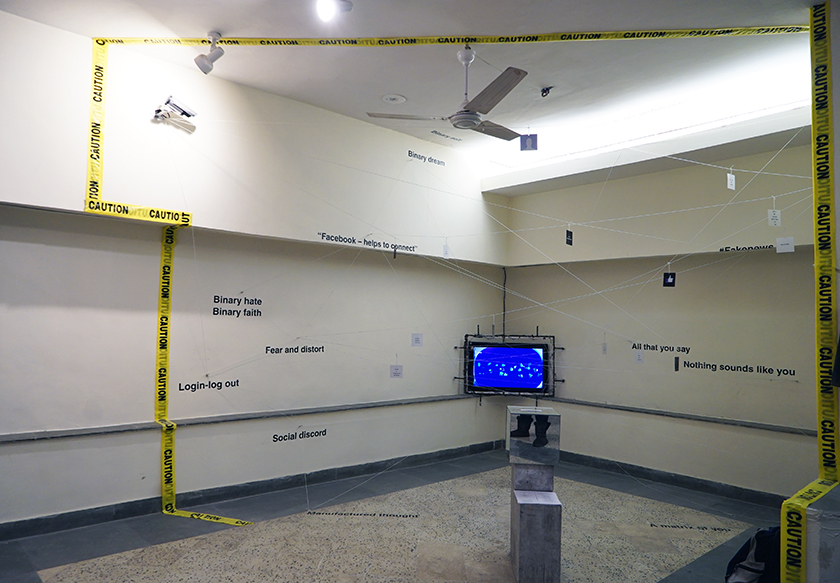
Aadit Basu
What is one imperative piece of advice you would give to someone who is just starting out?
We all need some kind of looking after. So, look for support, talk to people who you admire, and talk to the people you work with. Don’t be afraid to question things and keep educating yourself and learning about things outside your comfort zone.
What are you working on now? What should we look forward to?
I’m currently working on a few different series both in drawing and sculpture. I’m delving into the idea of story-telling through my work in a more immersive way, exploring new mediums and spaces. Also, we have begun our work for the third edition of TIRAF, which will happen in February, 2020.
Before you go – you might like to browse the Asian Curator curatorial archives . Contemporary art curators and international gallerists define their curatorial policies and share stories and insights about the inner runnings of the contemporary art world.











Add Comment